Bond under tensile cyclic loading
Table of contents
Project data
| Titel | Title TP Verbund unter Zugschwellbeanspruchung im Verbundvorhaben: WinConFat – Materialermüdung von On- und Offshore Windenergieanlagen aus Stahlbeton und Spannbeton unter hochzyklischer Beanspruchung | SP Bond under tensile cyclic loading within the joint research project WinConFat: Material fatigue of on- and offshore wind powered plants out of reinforced concrete and prestressed concrete under high cyclic loading Förderer | Funding Bundesministerium für Wirtschaft und Energie (BMWi) / WinConFat Zeitraum | Period 11/2016 – 02/2021 Verbundvorhabenleiter | Joint research project leader Prof. Dr.-Ing. Steffen Marx Teilprojektleiter | Subproject manager Prof. Dr.-Ing. Dr.-Ing. E.h. Manfred Curbach Bearbeiter | Contributor Dipl.-Ing. Marc Koschemann Projektpartner | Project Partners 6 Forschungseinrichtungen und 3 assoziierte Partner |
Report in the annual report 2021
Bond fatigue of reinforced concrete
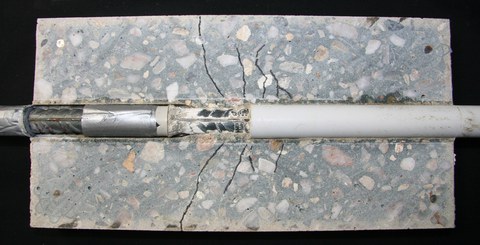
Crack pattern around the bond zone
Due to the expansion of wind energy in Germany, the construction of wind turbine towers subjected to cyclic loads has been steadily advanced in recent decades. For such support structures, the correct determination of the fatigue resistance is decisive for the stability but also for the economic use of materials. The joint research project WinConFat was dedicated to this topic. In addition to investigations of concrete and reinforcing steel by project partners such as Leibniz Universität Hannover, RWTH Aachen University and other universities, the Institute of Concrete Structures dealt with the bond behaviour of both building materials in the high-cycle fatigue range (N > 2 · 106).
Within the experimental test programme, 67 quasi-static and 56 cyclic pull-out and beam-end tests were carried out. The subjects of the tests were normal concrete and two high-strength concretes as well as reinforcing bars with a diameter of 16 mm. Although the bond length was only twice the bar diameter ds, tensile forces of up to 100 kN had to be applied in the static test to achieve bond failure. The results of the static reference tests showed a linear relationship between bond strength and concrete compressive strength. The pull-out forces for pull-out specimens were about 15 % higher than for beam-end specimens which showed significant cracking due to the lower concrete cover.
The bond fatigue tests were subjected to a uniform sinusoidal tensile loading and a lower level of 40 % and alternating upper levels between 75 and 80 % of the respective reference strength. For a loading frequency of 5 Hz, the achieved load cycles of all tests scatter in the range between 103 and 107, resulting in a very flat Wöhler line. Increasing the load frequency to 10 Hz or 20 Hz resulted in slightly higher numbers of load cycles. Specimens subjected to 10 million load cycles without failure were tested to the residual load capacity, whereby slightly increased bond strengths were found compared to the static reference value.
As a result of the investigations carried out, it can be stated that a fatigue failure of the bond can be quasi excluded for high-strength concretes (fcm ≥ 90 MPa) from a practical construction point of view.
Report in the annual report 2020
Always stay awake
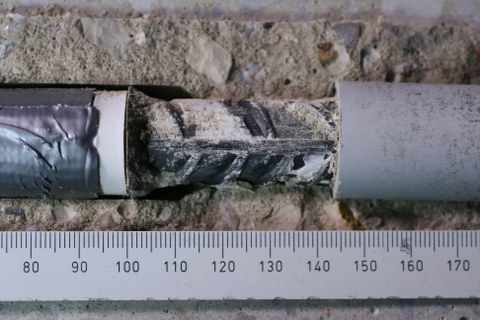
Bond zone after failure
Only an alert mind can be active, and a material can be used permanently – if it does not fatigue. Within the scope of the joint research project WinConFat, the fatigue behaviour of the material reinforced and prestressed concrete under highly cyclic loading is being researched. The increased use of wind energy, in particular, is accompanied by the desire for larger, more efficient and durable plants.
In addition to investigations of concrete and reinforcing steel by project partners such as Leibniz Universität Hannover, RWTH Aachen University and others, the Institute of Concrete Structures is investigating the bond behaviour of the composite building material in the high-cycle fatigue range (N > 2·106).
In the course of the investigations, 67 quasi-static and 45 cyclic pull-out and beam-end tests were carried out so far. For this purpose, two high-strength concretes and one normal strength concrete, as well as reinforcing bars with 16 mm diameter, were used. Although the bond length is only twice the bar diameter ds, tensile forces of up to 100 kN had to be applied in the static tests to achieve bond failure. For both high-strength concretes with compressive strength classes C80 and C120, pull-out tests achieved on average approx. 15% higher pullout forces than beam end tests. The decisive factor here was the large concrete cover of the pull-out test, which caused bigger confinement by the surrounding concrete.
The bond fatigue tests were loaded with a uniform sinusoidal tensile loading. The majority of the tests were performed with a loading frequency of 5 Hz. Also, specimens were cyclically loaded with twice and four times the frequency. The lower boundary was 40% of the static bond strength and the upper load levels were varied between 75 and 80% on a trial-by-trial basis. The test results so far indicate that the top load has a significant effect on the fatigue strength of the bond. In tests with upper load levels of 78% and higher, bond failure generally occurred at 10,000 to 200,000 load cycles. At lower load levels, load cycles of more than 2 million and up to 20 million could mostly be achieved without failure. The findings from this project will contribute to the development of applicable material models and determination of the service life of reinforced concrete structures, concerning bond fatigue in the high-cycle range.
Report in the annual report 2019
OSCILLATE FOR ETERNITY
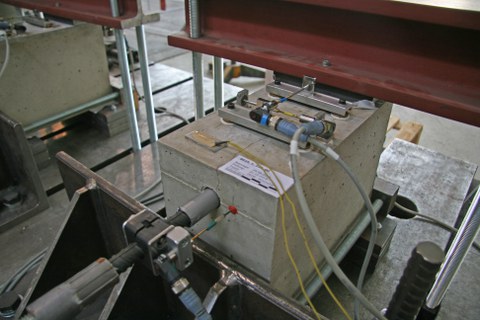
Beam-end test with splitting crack
The joint research project WinConFat aims at investigating the material fatigue of wind turbines made of reinforced and prestressed concrete under high cyclical loads. The increased use of wind energy is accompanied by the desire for larger, more efficient and durable plants.
In addition to investigations of concrete and reinforcing steel by a group of partners, the Institute of Concrete Structures is also concerned with the fundamental bond behaviour of both construction materials in the high cycle fatigue range (N > 2·106). So far, 34 quasi-static and 29 cyclic pull-out and beam end tests have been carried out. Two high-strength concretes as well as reinforcing steel with a bar diameter of 16 mm were used, in which the bond length was twice the bar diameter ds.
A comparison of the two types of test specimen shows that for C120 concrete, the quasi-static pull-out tests achieve on average approx. 15 % higher pull-out forces than the beam end tests. The reason for this is the better confinement of the surrounding concrete due to the large concrete cover in the specimens used for the pull-out test.
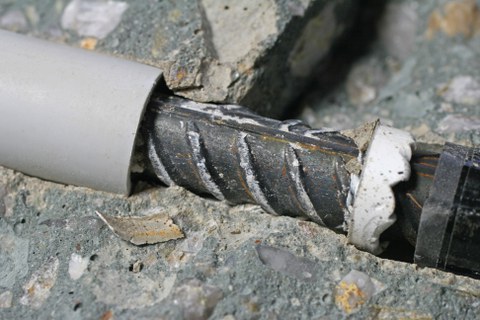
Bond zone after failure
In the cyclic tests, the specimens are loaded with a uniform sinusoidal tensile loading of 5 Hz. The lower boundary of the cyclic load is set at 40 % of the static bond strength and the upper load levels are varied between 75 and 80 %. The previous test results show that the upper load has a significant influence on the fatigue strength of the bond. In tests with an upper load level of up to 77 %, load cycle numbers of more than 2 million and up to 20 million without failure were achieved. At higher upper load levels, failure usually occurred at 10,000 to 200,000 load cycles. The non-linear increase in deformation in the event of failure is determined by the slip to load cycle relations. In addition to the documentation of the progress of deterioration by slip measurement, the crack propagation on the concrete surface is also recorded by means of inductive displacement transducers. In the further course of the project investigations of a normal concrete C40 and cyclic tests with load frequencies of 10 and 20 Hz are planned. The findings from this project should enable an accurate determination of the service life with regard to bond fatigue in the high cyclical range.
Report in the annual report 2018
VERBUNDERMÜDUNG VON STAHLBETON
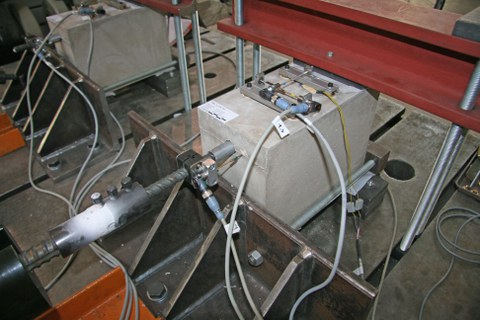
Messtechnische Erfassung während eines zyklischen Versuchs
With expansion of wind energy, there is a desire for larger, more efficient and long-lasting facilities. In order to make this possible, exact knowledge of the material behaviour under high-cyclic fatigue loading is necessary, because wind power plants are exposed to up to N = 109 load cycles during service life.
Hence, the ongoing joint research project WinConFat aims at investigating the fatigue behaviour of wind-powered plants made out of reinforced and prestressed concrete under high cyclic loading. Besides material studies for concrete and steel reinforcement by other project partners, the Institute of Concrete Structures of TU Dresden sets the focus on the investigation of the bond between both materials, when subjected to a very high fatigue cycle regime (N > 2·106).
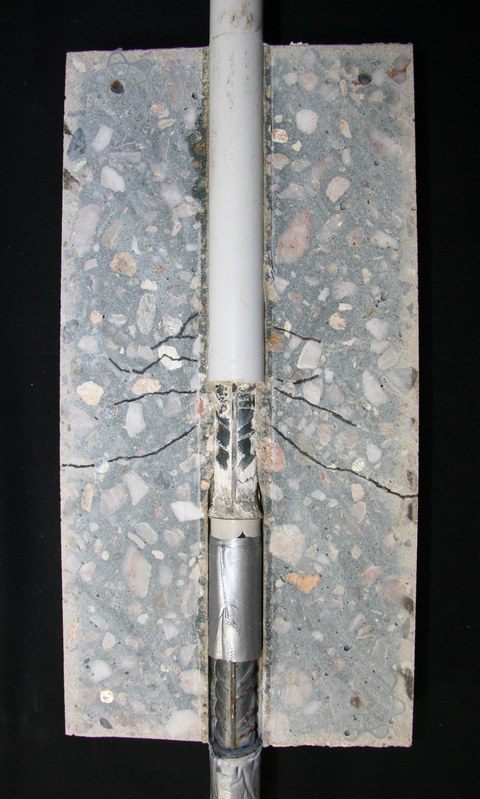
Rissbild im Verbundbereich
Therefore, 20 monotonic and 16 cyclic tests have been carried out on beam-end specimens so far. In the tests, a high-strength concrete C120 is used and the bond length is twice the bar diameter. In reference to the monotonic pull-out force (approx. 70 kN), a sinusoidal tensile load with a lower load level of 40 % and an upper load level between 75 and 80 % is applied during the cyclic testing. The first results show that even small changes in the upper load level have a considerable influence on the lifetime of the experiments. For example, the samples exposed to an upper load level of 77 % were able to withstand 10 million load cycles, but an upper load level of 80 % caused a pull-out failure after already a half million load cycles. Based on the recorded slip to load cycle relation, the progress of deterioration is documented and the non-linear deformation increase in case of failure is depicted.
In addition, the crack propagation on the concrete surface is detected by means of inductive displacement transducers. Besides the recording with measurement instrumentation, the documentation of crack patterns and a detailed inspection of the damaged bond zone helps to improve the understanding of the failure progress.
Within the course of the project, the test program includes experiments on pull-out specimens and the investigation of three other types of concrete. A result of the project is the possibility to evaluate the lifetime of bond fatigue under high cyclic loading.
Report in the yearbook 2017
BOND UNDER HIGH CYCLIC LOADING
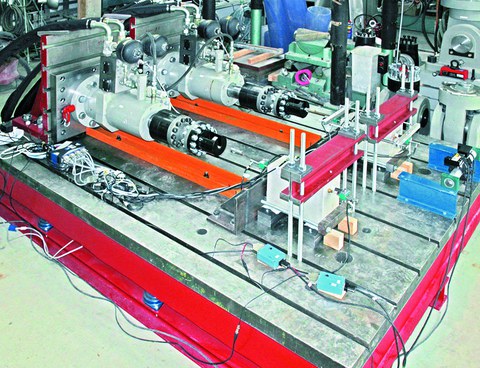
Test setup with two specimens
Due to the progressive research and innovation within the scientific community, high performance concrete plays an important role as a construction material in structural engineering. Its behaviour needs to be accurately predicted, not only at ultimate limit state and serviceability under static loading, but also under high cyclic loading. Examples are wind exposed structures such as wind power plants, which have to withstand up to 109 load reversal cycles during service life.
The goal of the actual joint research project WinConFat is to investigate the fatigue behaviour of wind powered plants made out of reinforced and prestressed concrete under high cyclic loading. Besides material studies for concrete and steel reinforcement through other project partners, the Institute of Concrete Structures of TU Dresden sets the focus on the investigation of the bond between both materials, when subjected to a very high fatigue cycle regime. The role of the concrete’s compressive strength, the loading frequency, and loading rate is investigated as well. It is intended to execute about 110 experimental tests with various type of concrete, varying from normal up to ultra-high performance concrete and two different specimen types.These are on the one hand the well-known pull-out test by RILEM and on the other hand, the beam-end test, which is more often used in North America. Depending on the static bond strength, the tensile cyclic loading will be applied with a frequency varying from 5 up to 20 Hz. The intention is to find a methodology to transfer the results of high cycle laboratory tests to mimic the real strain experienced by a windmill-powered plant.
To operate the experimental studies, a test setup has been developed, which allows the simultaneous testing of two specimens. For every series, four specimens will be casted, in which two will be used as static reference and two for the cyclic tests.
It is intended to detect and show the progress of deterioration by using the recorded bond stress-slip-relation and the slip ratio for a given number of load cycles. By working with a defined lower stress level and different upper stress levels, diverse stress cycles will be investigated. Their relation to the bearable number of load cycles until failure shall offer an appraisal for design life.
